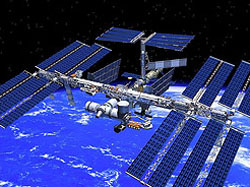The first part of the ISS was launched on November 20, 1998. Building the ISS required more than 50 assembly and utilization flights. Of those flights, 39 were planned to be Space Shuttle flights. In addition to the assembly and utilization flights, approximately 30 Progress spacecraft flights were required to provide logistics. When assembly was completed, the ISS had a pressurized volume of 1,200 cubic meters, a mass of 419,000 kilograms, 110 kilowatts of power output, a truss 108.4 meters long, modules 74 meters long, and a crew of six. To view a short movie of the assembly of the International Space Station, click on the picture of it shown to the right.
 At the end of 2005 many changes had been made to the originally planned ISS, modules and other structures. Many were cancelled or replaced and the number of remaining Shuttle flights to the ISS had been reduced to 18 during the years 2006-2010.
At the end of 2005 many changes had been made to the originally planned ISS, modules and other structures. Many were cancelled or replaced and the number of remaining Shuttle flights to the ISS had been reduced to 18 during the years 2006-2010.
Due to the International Space Station's size, quite often it can be seen passing over when it is within a few hundred miles of your location. The only problem is that you need to know the local time when it's passing over, where to look and whether it will be a visible pass or not. If you don't have that info, you're going to get a pretty stiff neck, looking up in the sky all night long!
The purpose of this web page is to give you information on the ISS so you can see it when it has a visible pass over your area. Actually, the ISS goes around the earth about every hour and a half and passes over many times when you will NOT be able to see it. To have a visible sighting, there are three requirements. First, it has to be over your location, which makes a lot of sense; Second, the ISS must be lit by the sun; Third, the sun needs to below the horizon. The sky doesn't need to be completely dark and sightings just after sunset and before sunrise will show up very good.
Listed below are several links that will take you directly to a web page listing the pass-over times for those cities. The web page that these links lead to will have a chart showing the local times for the visible passes and where to look. The chart contains pass-over information for the next ten days. If you wish to know visible pass-overs beyond that, there is a "Next" option (shown as ">") on the chart's web page that will give you that information.
If you have a problem making out some of the info on the charts, the NOTES below the list of cities may help you understand it a little better.